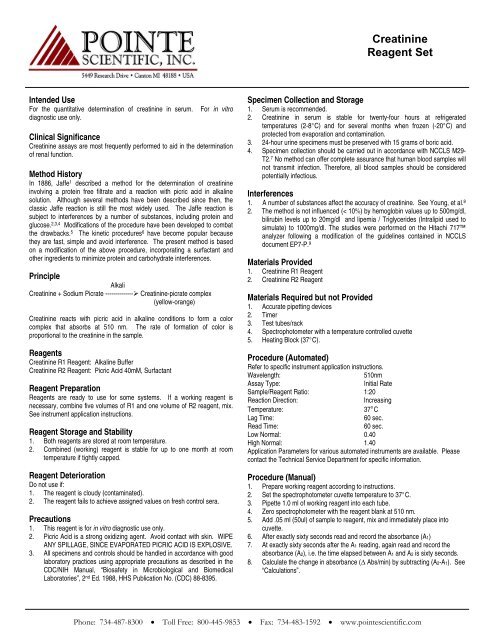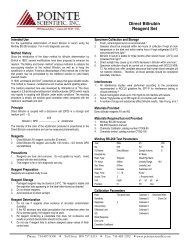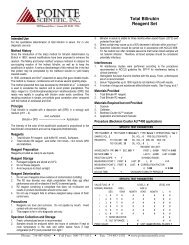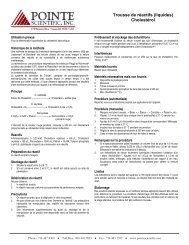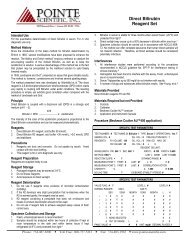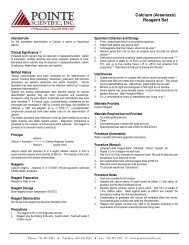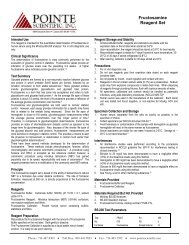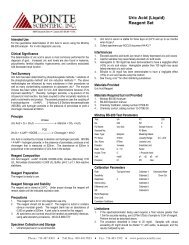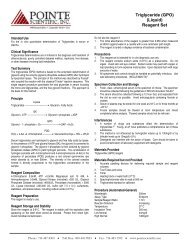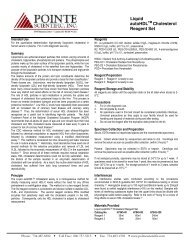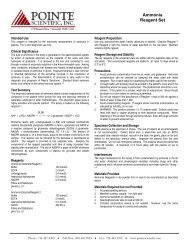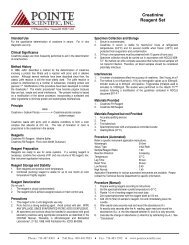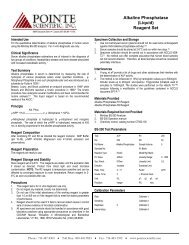Creatinine Reagent Set - Pointe Scientific, Inc.
Creatinine Reagent Set - Pointe Scientific, Inc.
Creatinine Reagent Set - Pointe Scientific, Inc.
You also want an ePaper? Increase the reach of your titles
YUMPU automatically turns print PDFs into web optimized ePapers that Google loves.
Intended Use<br />
For the quantitative determination of creatinine in serum. For in vitro<br />
diagnostic use only.<br />
Clinical Significance<br />
<strong>Creatinine</strong> assays are most frequently performed to aid in the determination<br />
of renal function.<br />
Method History<br />
In 1886, Jaffe 1 described a method for the determination of creatinine<br />
involving a protein free filtrate and a reaction with picric acid in alkaline<br />
solution. Although several methods have been described since then, the<br />
classic Jaffe reaction is still the most widely used. The Jaffe reaction is<br />
subject to interferences by a number of substances, including protein and<br />
glucose. 2,3,4 Modifications of the procedure have been developed to combat<br />
the drawbacks. 5 The kinetic procedures 6 have become popular because<br />
they are fast, simple and avoid interference. The present method is based<br />
on a modification of the above procedure, incorporating a surfactant and<br />
other ingredients to minimize protein and carbohydrate interferences.<br />
Principle<br />
Alkali<br />
<strong>Creatinine</strong> + Sodium Picrate --------------� <strong>Creatinine</strong>-picrate complex<br />
(yellow-orange)<br />
<strong>Creatinine</strong> reacts with picric acid in alkaline conditions to form a color<br />
complex that absorbs at 510 nm. The rate of formation of color is<br />
proportional to the creatinine in the sample.<br />
<strong>Reagent</strong>s<br />
<strong>Creatinine</strong> R1 <strong>Reagent</strong>: Alkaline Buffer<br />
<strong>Creatinine</strong> R2 <strong>Reagent</strong>: Picric Acid 40mM, Surfactant<br />
<strong>Reagent</strong> Preparation<br />
<strong>Reagent</strong>s are ready to use for some systems. If a working reagent is<br />
necessary, combine five volumes of R1 and one volume of R2 reagent, mix.<br />
See instrument application instructions.<br />
<strong>Reagent</strong> Storage and Stability<br />
1. Both reagents are stored at room temperature.<br />
2. Combined (working) reagent is stable for up to one month at room<br />
temperature if tightly capped.<br />
<strong>Reagent</strong> Deterioration<br />
Do not use if:<br />
1. The reagent is cloudy (contaminated).<br />
2. The reagent fails to achieve assigned values on fresh control sera.<br />
Precautions<br />
1. This reagent is for in vitro diagnostic use only.<br />
2. Picric Acid is a strong oxidizing agent. Avoid contact with skin. WIPE<br />
ANY SPILLAGE, SINCE EVAPORATED PICRIC ACID IS EXPLOSIVE.<br />
3. All specimens and controls should be handled in accordance with good<br />
laboratory practices using appropriate precautions as described in the<br />
CDC/NIH Manual, “Biosafety in Microbiological and Biomedical<br />
Laboratories”, 2 nd Ed. 1988, HHS Publication No. (CDC) 88-8395.<br />
<strong>Creatinine</strong><br />
<strong>Reagent</strong> <strong>Set</strong><br />
Specimen Collection and Storage<br />
1. Serum is recommended.<br />
2. <strong>Creatinine</strong> in serum is stable for twenty-four hours at refrigerated<br />
temperatures (2-8°C) and for several months when frozen (-20°C) and<br />
protected from evaporation and contamination.<br />
3. 24-hour urine specimens must be preserved with 15 grams of boric acid.<br />
4. Specimen collection should be carried out in accordance with NCCLS M29-<br />
T2. 7 No method can offer complete assurance that human blood samples will<br />
not transmit infection. Therefore, all blood samples should be considered<br />
potentially infectious.<br />
Interferences<br />
1. A number of substances affect the accuracy of creatinine. See Young, et al. 8<br />
2. The method is not influenced (< 10%) by hemoglobin values up to 500mg/dl,<br />
bilirubin levels up to 20mg/dl and lipemia / Triglycerides (Intralipid used to<br />
simulate) to 1000mg/dl. The studies were performed on the Hitachi 717<br />
analyzer following a modification of the guidelines contained in NCCLS<br />
document EP7-P. 9<br />
Materials Provided<br />
1. <strong>Creatinine</strong> R1 <strong>Reagent</strong><br />
2. <strong>Creatinine</strong> R2 <strong>Reagent</strong><br />
Materials Required but not Provided<br />
1. Accurate pipetting devices<br />
2. Timer<br />
3. Test tubes/rack<br />
4. Spectrophotometer with a temperature controlled cuvette<br />
5. Heating Block (37°C).<br />
Procedure (Automated)<br />
Refer to specific instrument application instructions.<br />
Wavelength: 510nm<br />
Assay Type: Initial Rate<br />
Sample/<strong>Reagent</strong> Ratio: 1:20<br />
Reaction Direction: <strong>Inc</strong>reasing<br />
Temperature: 37°C<br />
Lag Time: 60 sec.<br />
Read Time: 60 sec.<br />
Low Normal: 0.40<br />
High Normal: 1.40<br />
Application Parameters for various automated instruments are available. Please<br />
contact the Technical Service Department for specific information.<br />
Procedure (Manual)<br />
1. Prepare working reagent according to instructions.<br />
2. <strong>Set</strong> the spectrophotometer cuvette temperature to 37°C.<br />
3. Pipette 1.0 ml of working reagent into each tube.<br />
4. Zero spectrophotometer with the reagent blank at 510 nm.<br />
5. Add .05 ml (50ul) of sample to reagent, mix and immediately place into<br />
cuvette.<br />
6. After exactly sixty seconds read and record the absorbance (A1)<br />
7. At exactly sixty seconds after the A1 reading, again read and record the<br />
absorbance (A2), i.e. the time elapsed between A1 and A2 is sixty seconds.<br />
8. Calculate the change in absorbance (Δ Abs/min) by subtracting (A2-A1). See<br />
“Calculations”.<br />
Phone: 734-487-8300 • Toll Free: 800-445-9853 • Fax: 734-483-1592 • www.pointescientific.com
NOTE: If the spectrophotometer in use requires a volume greater than 1.0<br />
ml for accurate reading, use 0.20 ml (200 ul) sample to 3.0 ml reagent.<br />
Perform as above.<br />
Limitations<br />
Samples with values above 25 mg/dl should be diluted 1:1, re-assayed and<br />
results multiplied by two.<br />
Calibration<br />
Use an NIST-traceable creatinine standard (2.5mg/dl) or serum calibrator.<br />
The procedure should be calibrated according to the instrument<br />
manufacturer’s calibration instructions. If control results are found to be out<br />
of range, the procedure should be re-calibrated.<br />
Calculation<br />
The creatinine value of the unknown is determined by comparing its<br />
absorbance change with that of a known standard.<br />
Mg/dl = Δ Abs (Unknown) x Concentration of Std.<br />
Δ Abs (Standard) (mg/dl)<br />
Where: Δ Abs. = Absorbance change between readings (A2-A1)<br />
Sample Calculation<br />
If: Δ Abs/Unknown = 0.02<br />
Δ Abs/Standard = 0.05<br />
Conc. of Standard = 2.5 mg/dl<br />
Then: 0.02 x 2.5 = 1.0 mg/dl creatinine<br />
0.05<br />
Quality Control<br />
The integrity of the reaction should be monitored by use of normal and<br />
abnormal control sera with known creatinine values. These controls should<br />
be run at least with every working shift in which creatinine assays are<br />
performed. It is recommended that each laboratory establish their own<br />
frequency of control determination.<br />
Expected Values<br />
0.40 – 1.40 mg/dl<br />
It is highly recommended that each laboratory establish its own reference<br />
range.<br />
Performance (Data generated using a Roche Hitachi 747 analyzer)<br />
1. Assay Range: 0.1-25.0 mg/dL<br />
2. Correlation: A patient correlation of 126 specimens over the range of<br />
about 0.4 to 11.3 mg/dL creatinine yielded y=1.09 x + 0.02, r 2 = 0.998<br />
and S.E. = 0.22.<br />
3. Precision: Precision studies were performed on a Technicon RA500<br />
following a modification of the guidelines which are contained in the<br />
NCCLS document EP5-T2. 10<br />
Within Day Day to Day<br />
Mean S.D. C.V.% Mean S.D. C.V.%<br />
1.4 0.03 2.2 1.4 0.05 3.6<br />
7.1 0.09 1.3 7.0 1.10 1.6<br />
<strong>Creatinine</strong><br />
<strong>Reagent</strong> <strong>Set</strong><br />
References<br />
1. Jaffe, M., Z. Physiol. Chem. 10:391 (1886).<br />
2. DiGiorgio, J., Clinical Chemistry: Principles and Technics, 2 nd Ed., Edited by<br />
Henry, R.J., et al, Hagerstown (MD), Harper & Row, pp. 541-553 (1974).<br />
3. Cook, J.G.H., Ann. Clin. Biochem. 12:219 (1975).<br />
4. Taussky, H.H., Standard Methods of Clinical Chemistry, Vol. 3, New York<br />
Academic Press, p. 99 (1966).<br />
5. Heinegard, D., Tiderstom, G., Clin. Chem. Acta, 43:305 (1973).<br />
6. Fabiny, D.L., Ertingshausen, G., Clin. Chem. 17:391 (1971).<br />
7. NCCLS document “Protection of Laboratory Workers form Infectious Disease<br />
Transmitted by Blood, Body Fluids, and Tissue”, 2 nd Ed. (1991).<br />
8. Young, D.S. et al, Clin. Chem. 21:1D (1975).<br />
9. NCCLS document “Interference testing in Clinical Chemistry”, 2 nd Ed. (1992).<br />
10. NCCLS document “Evaluation of Precision Performance of Clinical<br />
Chemistry Devices”, 2 nd Ed., (1992).<br />
Manufactured by <strong>Pointe</strong> <strong>Scientific</strong>, <strong>Inc</strong>.<br />
5449 Research Drive, Canton, MI 48188<br />
European Authorized Representative:<br />
Obelis s.a.<br />
Boulevard Général Wahis 53<br />
1030 Brussels, BELGIUM<br />
Tel: (32)2.732.59.54 Fax:(32)2.732.60.03 email: mail@obelis.net<br />
Rev. 11/11 P803-C7539-01


